

|
| HRVATSKA | CROATIA |
| županija: Dubrovačko-neretvanska |
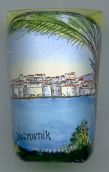
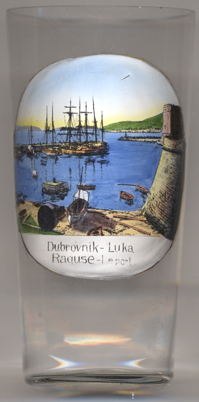 The oldes traces of settlements in the vicinity of Dubrovnik date from the times of Illyrian and Roman rules. During
the 7th century, the inhabitants of the island of Epidaurum (today Cavtat) had to flee from Awars and Slavs and founded
a village on the rocky island of Lausa. The name later changed to Rausa and became the origin of the Italian
name, Ragusa. About at the same time a slav village called Dubrava developed on the foot of the hill Srđ
(Srdj). Both villages merged and formed an independent city state which only formally was under Byzantine sovereignty. In
1205, the Republic of Venice eventually managed to conquer the city. In 1358, after the Peace of
Zadar, the city regained its independence, this time under formal Croat-Hungarian rule which
lasted until 1526. From the 14th until the 16th century, the city was an important trading nation in the adriatic sea.
At the end of the 16th century the city state kept a fleet of 200 ships and 5000 seamen. In 1808 the independece of the
city state was ended by Napoleon. At the Congress of Vienna 1815 Dubrovnik/Ragusa became part of the Austrian Empire where
it remained until 1918. The rich history and the perfect condition of the old town earned Dubrovnik the name 'Pearl of the
Adriatic'. Despite being declared a World Cultural Heritage by the UNESCO in 1979
(see also list of other UNESCO heritage sites depicted on glasses of this collection),
Dubrovnik suffered damage during the Yugoslav Wars of Secession in
1991. Seven palaces in the historic town centre were destroyed completely and many other historic buildings were damaged by
the bombardement by the Yugoslav Army. Major restoration works are in progress since then.
The oldes traces of settlements in the vicinity of Dubrovnik date from the times of Illyrian and Roman rules. During
the 7th century, the inhabitants of the island of Epidaurum (today Cavtat) had to flee from Awars and Slavs and founded
a village on the rocky island of Lausa. The name later changed to Rausa and became the origin of the Italian
name, Ragusa. About at the same time a slav village called Dubrava developed on the foot of the hill Srđ
(Srdj). Both villages merged and formed an independent city state which only formally was under Byzantine sovereignty. In
1205, the Republic of Venice eventually managed to conquer the city. In 1358, after the Peace of
Zadar, the city regained its independence, this time under formal Croat-Hungarian rule which
lasted until 1526. From the 14th until the 16th century, the city was an important trading nation in the adriatic sea.
At the end of the 16th century the city state kept a fleet of 200 ships and 5000 seamen. In 1808 the independece of the
city state was ended by Napoleon. At the Congress of Vienna 1815 Dubrovnik/Ragusa became part of the Austrian Empire where
it remained until 1918. The rich history and the perfect condition of the old town earned Dubrovnik the name 'Pearl of the
Adriatic'. Despite being declared a World Cultural Heritage by the UNESCO in 1979
(see also list of other UNESCO heritage sites depicted on glasses of this collection),
Dubrovnik suffered damage during the Yugoslav Wars of Secession in
1991. Seven palaces in the historic town centre were destroyed completely and many other historic buildings were damaged by
the bombardement by the Yugoslav Army. Major restoration works are in progress since then.
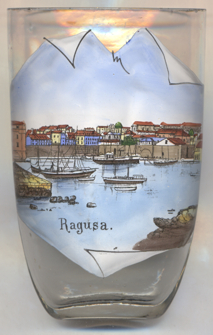
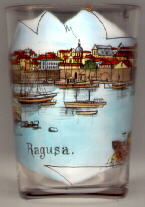
The only building easily recognizable on the small picture on glasses no. 3840 [left] and no. 328
[right] is the  cathedral
cathedral
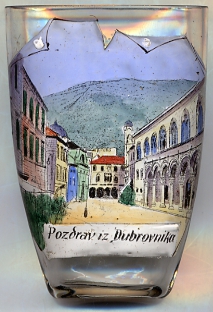 The
The  Rectors' Palace [left, no. 2832: right],
one of the most significant monuments of profane architecture on the Croatian coast, was the administrative centre of the
Dubrovnik Republic. Its style is basically Gothic, with Renaissance and Baroque reconstructions. In the 15th century
the Palace was destroyed twice in gunpowder explosions. Restored in late Gothic style after the first explosion in 1435, the
Palace got its present-day size with the central atrium and front portico. The second gunpowder explosion in 1463 destroyed
the western façade of the Palace, which was subsequently restored in Renaissance style. After the earthquake of 1667 the
atrium was partially reconstructed with an impressive Baroque staircase. During his one-month mandate the Rector of Dubrovnik
lived in the Palace, which also housed the Minor and Major Council hall, the Rectors residence, the courtroom, administration
office, prisons, an arsenal and gunpowder store-house. Today the Rectors Palace houses the Cultural-historic Department of
the Dubrovnik Museum.
[http://www.tzdubrovnik.hr/eng/vodic_novost.php?id=1539&id_main=1517#.UfDYSaxqeSo]
Rectors' Palace [left, no. 2832: right],
one of the most significant monuments of profane architecture on the Croatian coast, was the administrative centre of the
Dubrovnik Republic. Its style is basically Gothic, with Renaissance and Baroque reconstructions. In the 15th century
the Palace was destroyed twice in gunpowder explosions. Restored in late Gothic style after the first explosion in 1435, the
Palace got its present-day size with the central atrium and front portico. The second gunpowder explosion in 1463 destroyed
the western façade of the Palace, which was subsequently restored in Renaissance style. After the earthquake of 1667 the
atrium was partially reconstructed with an impressive Baroque staircase. During his one-month mandate the Rector of Dubrovnik
lived in the Palace, which also housed the Minor and Major Council hall, the Rectors residence, the courtroom, administration
office, prisons, an arsenal and gunpowder store-house. Today the Rectors Palace houses the Cultural-historic Department of
the Dubrovnik Museum.
[http://www.tzdubrovnik.hr/eng/vodic_novost.php?id=1539&id_main=1517#.UfDYSaxqeSo]
The  Sponza Palace [left, no. 2832: background centre], which also served
as the mint and arsenal, was constructed in the 16th century. The Palace was the liveliest commercial centre of the
City, and in the 17th century it became the meeting place of members of the Academy of the Learned, who used to discuss
literature, arts and science. Today the Sponza Palace houses the Dubrovnik Archives, considered to be among the richest in
Europe.
[http://www.tzdubrovnik.hr/eng/vodic_novost.php?id=1534&id_main=1517#.UfDMbqxqeSo]
Sponza Palace [left, no. 2832: background centre], which also served
as the mint and arsenal, was constructed in the 16th century. The Palace was the liveliest commercial centre of the
City, and in the 17th century it became the meeting place of members of the Academy of the Learned, who used to discuss
literature, arts and science. Today the Sponza Palace houses the Dubrovnik Archives, considered to be among the richest in
Europe.
[http://www.tzdubrovnik.hr/eng/vodic_novost.php?id=1534&id_main=1517#.UfDMbqxqeSo]
The  City Bell-Tower [left, no. 2832: background right]
was built in 1444. The large bell was cast in 1506. The two famous figures called Zelenci, who strike the hours with their
hammers, were cast in bronze at the same period. The Tower was damaged in the earthquake of 1667. In order to prevent the
collapse, the old Bell-Tower was rebuilt in 1929 and the original figures of Zelenci were replaced by their copies. The
originals are now exhibited at the Sponza Palace Atrium.
[http://www.tzdubrovnik.hr/eng/vodic_novost.php?id=1533&id_main=1517#.UfDMlqxqeSo]
City Bell-Tower [left, no. 2832: background right]
was built in 1444. The large bell was cast in 1506. The two famous figures called Zelenci, who strike the hours with their
hammers, were cast in bronze at the same period. The Tower was damaged in the earthquake of 1667. In order to prevent the
collapse, the old Bell-Tower was rebuilt in 1929 and the original figures of Zelenci were replaced by their copies. The
originals are now exhibited at the Sponza Palace Atrium.
[http://www.tzdubrovnik.hr/eng/vodic_novost.php?id=1533&id_main=1517#.UfDMlqxqeSo]
The  church of St. Blaise [left, no. 2832: background left]
was constructed in 1706–1715 in the flamboyant Venetian Baroque style on the site of a previous, 14th century
Romanesque church. Damaged during the earthquake for the first time, the old church had been destroyed completely by the
devastating fire in 1706. Everything disappeared in flames, apart from the silver statue of St. Blaise. After years
spent in exile at the Church of St Nicholas at Prijeko, the statue was returned to its old place when the new church was
completed in 1715. St. Blaise (sv. Vlaha) has been honoured as the patron saint of Dubrovnik from the
10th century. According to the chroniclers of Dubrovnik, St. Blaise saved the people of Dubrovnik in the
10th century when the Venetians anchored their ships in Gruž and in front of the Island of Lokrum.
[http://www.tzdubrovnik.hr/eng/vodic_novost.php?id=1556&id_main=1548#.UfDY-KxqeSo]
church of St. Blaise [left, no. 2832: background left]
was constructed in 1706–1715 in the flamboyant Venetian Baroque style on the site of a previous, 14th century
Romanesque church. Damaged during the earthquake for the first time, the old church had been destroyed completely by the
devastating fire in 1706. Everything disappeared in flames, apart from the silver statue of St. Blaise. After years
spent in exile at the Church of St Nicholas at Prijeko, the statue was returned to its old place when the new church was
completed in 1715. St. Blaise (sv. Vlaha) has been honoured as the patron saint of Dubrovnik from the
10th century. According to the chroniclers of Dubrovnik, St. Blaise saved the people of Dubrovnik in the
10th century when the Venetians anchored their ships in Gruž and in front of the Island of Lokrum.
[http://www.tzdubrovnik.hr/eng/vodic_novost.php?id=1556&id_main=1548#.UfDY-KxqeSo]
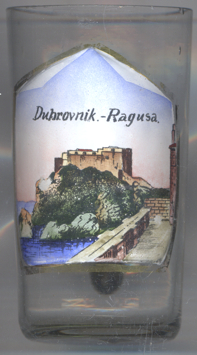
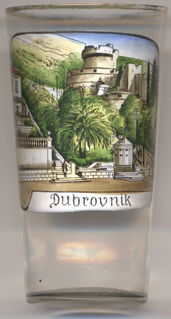 The
The  fortress St. Lawrence (trđava Lovrijenac) [left, no. 3498]
is located outside Dubrovnik's western wall on a rock about 37 m above sea level. Famous for its plays and importance
in resisting Venetian rule, it overshadows the two entrances to the city, from the sea and by land. The fortress was built
in the 11th century (some sources mention that it had been built within just three months in 1018 or 1038). The first
mention in a docuent, however, only dates from 1301. Further additions date from the 14th, 15th and 6th centuries. Due to
its triangular ground plan it is popularly called the 'Gibraltar of Dubrovnik'. Since the 1950s it is the site of the annual
Dubrovnik summer festival.
[https://en.wikipedia.org/wiki/Lovrijenac, https://de.wikipedia.org/wiki/Festung_Lovrijenac]
fortress St. Lawrence (trđava Lovrijenac) [left, no. 3498]
is located outside Dubrovnik's western wall on a rock about 37 m above sea level. Famous for its plays and importance
in resisting Venetian rule, it overshadows the two entrances to the city, from the sea and by land. The fortress was built
in the 11th century (some sources mention that it had been built within just three months in 1018 or 1038). The first
mention in a docuent, however, only dates from 1301. Further additions date from the 14th, 15th and 6th centuries. Due to
its triangular ground plan it is popularly called the 'Gibraltar of Dubrovnik'. Since the 1950s it is the site of the annual
Dubrovnik summer festival.
[https://en.wikipedia.org/wiki/Lovrijenac, https://de.wikipedia.org/wiki/Festung_Lovrijenac]
The  Minčeta Tower [right, no. 3686]
is part of the Dubrovnik's historic city walls and dates from the 15th century. It was built in 1463, at the height of
the Turkish threat. Originally as a strong four-sided fort, it is the most prominent point in the defensive system towards
the land. The tower's name derives from the name of the Menčetić family, who owned the ground upon which the
tower was built. By its height and impressive volume, the tower dominates the northwestern high part of the city and its
walls. In the middle of the 15th century, a new round tower was built around the earlier quadrilateral fort, joined to
the new system of low scarp walls. The tower was completed in 1464 and became the symbol of the unconquerable city of
Dubrovnik.
[https://en.wikipedia.org/wiki/Walls_of_Dubrovnik]
Minčeta Tower [right, no. 3686]
is part of the Dubrovnik's historic city walls and dates from the 15th century. It was built in 1463, at the height of
the Turkish threat. Originally as a strong four-sided fort, it is the most prominent point in the defensive system towards
the land. The tower's name derives from the name of the Menčetić family, who owned the ground upon which the
tower was built. By its height and impressive volume, the tower dominates the northwestern high part of the city and its
walls. In the middle of the 15th century, a new round tower was built around the earlier quadrilateral fort, joined to
the new system of low scarp walls. The tower was completed in 1464 and became the symbol of the unconquerable city of
Dubrovnik.
[https://en.wikipedia.org/wiki/Walls_of_Dubrovnik]
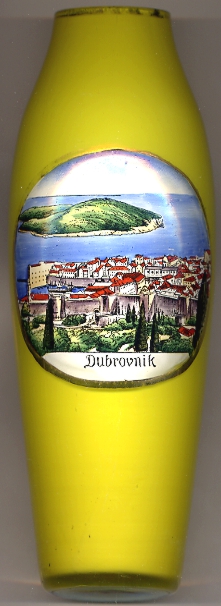 The island depicted in the background of the picture on glass no. 2748 [left, no. 2748]
is
The island depicted in the background of the picture on glass no. 2748 [left, no. 2748]
is  Lokrum
Lokrum
![[scale]](lineal.jpg)